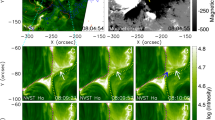Abstract
Slow-mode shocks produced by reconnection in the corona can provide the thermal energy necessary to sustain flare loops for many hours. These slow shocks have a complex structure because strong thermal conduction along field lines dissociates the shocks into conduction fronts and isothermal subshocks. Heat conducted along field lines mapping from the subshocks to the chromosphere ablates chromospheric plasma and thereby creates the hot flare loops and associated flare ribbons. Here we combine a non-coplanar compressible reconnection theory with simple scaling arguments for ablation and radiative cooling, and predict average properties of hot and cool flare loops as a function of the coronal vector magnetic field. For a coronal field strength of 100 G the temperature of the hot flare loops decreases from 1.2 × 107 K to 4.0 × 106 K as the component of the coronal magnetic field perpendicular to the plane of the loops increases from 0% to 86% of the total field. When the perpendicular component exceeds 86% of the total field or when the altitude of the reconnection site exceeds 106km, flare loops no longer occur. Shock enhanced radiative cooling triggers the formation of cool Hα flare loops with predicted densities of ≈ 1013 cm−3, and a small gap of ≈ 103 km is predicted to exist between the footpoints of the cool flare loops and the inner edges of the flare ribbons.
Similar content being viewed by others
References
Anderson, D. V.: 1975, J. Comp. Phys. 17, 246.
Antiochos, S. K.: 1980, Astrophys. J. 236, 270.
Antiochos, S. K. and Sturrock, P. A.: 1978, Astrophys. J. 220, 1137.
Bruzek, A.: 1964, Astrophys. J. 140, 746.
Carmichael, H.: 1964, in W. N. Hess (ed.), AAS-NASA Symposium on the Physics of Solar Flares, NASA SP-50, p.451.
Cargill, P. J. and Priest, E. R.: 1983, Astrophys. J. 266, 383.
Chevalier, R. A. and Theys, J. C: 1975, Astrophys. J. 195, 53.
Coroniti, F. V.: 1970, J. Plasma Phys. 4, 265.
Cox, D. P.: 1972, Astrophys. J. 178, 143.
Craig, I. J. D. and McClymont, A. N.: 1976, Solar Phys. 50, 133.
Craig, I. J. D. and McClymont, A. N.: 1981, Solar Phys. 70, 97.
Edmiston, J. P. and Kennel, C. F.: 1986, J. Geophys. Res. 91, 1361.
Ferraro, V. C. A. and Plumpton, C.: 1966, An Introduction to Magneto-Fluid Mechanics, Clarendon Press, Oxford, p. 101.
Forbes, T. G.: 1986, Astrophys. J. 305, 553.
Forbes, T. G. and Malherbe, J. M: 1986, Astrophys. J. 302, L67.
Forbes, T. G. and Priest, E. R.: 1983, Solar Phys. 88, 211.
Heinzel, P. and Karlický, M.: 1987, Solar Phys. 110, 343.
Hildner, E.: 1974, Solar Phys. 35, 123.
Hirayama, T.: 1974, Solar Phys. 34, 323.
Jakimiec, J., Sylwester, B., Sylwester, J., Lemen, J. R., Mewe, R., Bentley, R. D., Peres, G., Serio, S., and Schrijver J.: 1987, in V. E. Stepanov and V. N. Obridko (eds.), Solar Maximum Analysis, VNU Science Press, Utrecht, p. 91.
Kennel, C. F.: 1987, J. Geophys. Res. 92, 13427.
Kleczek, J.: 1964, in W. N. Hess (ed.), AAS-NASA Symposium on the Physics of Solar Flares, NASA SP-50, p. 77.
Kopp, R. A. and Pneuman, G. W.: 1976, Solar Phys. 50, 85.
Landau, L. D. and Lifshitz, E. M.: 1959, Fluid Mechanics, Pergamon Press, London, p. 342.
Leroy, J. L., Bommier, V., and Sahal-Brechot, S.: 1984, Astron. Astrophys. 131, 33.
Lin, H.-A., Lin, R. P., and Kane, S. R.: 1985, Solar Phys. 99, 263.
Malherbe, J. M.: 1987, Thèse de Doctorat d'État des Sciences, University de Paris VII, p. 154.
Malherbe, J. M., Forbes, T. G., and Priest, E. R.: 1984, The Hydromagnetics of the Sun, ESA SP-220, p. 119.
Martin, S. F.: 1979, Solar Phys. 64, 165.
McCabe, M.: 1973, Solar Phys. 30, 439.
McClymont, A. N. and Canfield, R. C.: 1983, Astrophys. J. 265, 497.
Morishita, H.: 1985, Tokyo Astron. Bull. 272, 3123.
Nolte, J. T., Gerassimenko, M., Krieger, A. S., and Petrasso, R. D.: 1979, Solar Phys. 62, 123.
Ohki, K.: 1975, Solar Phys. 45, 435.
Petschek, H. E.: 1964, in W. N. Hess (ed.), AAS-NASA Symposium on the Physics of Solar Flares, NASA SP-50, p. 425.
Podgorny, A. I. and Syrovatsky, S. L.: 1981, Soviet J. Plasma Phys. 7, 580 (English translation).
Poletto, G. and Kopp, R. A.: 1986, in D. F. Neidig (ed.), The Lower Atmosphere of Solar Flares, National Solar Observatories, Sacramento Peak, NM, p. 453.
Priest, E. R.: 1982a, Solar Phys. 86, 33.
Priest, E. R.: 1982b, Solar Magnetohydrodynamics, D. Reidel Publ. Co., Dordrecht, Holland, p. 73.
Rosner, R., Tucker, W. H., and Vaiana, G. S.: 1978, Astrophys. J. 220, 643.
Rust, D. M. and Bar, V.: 1973, Solar Phys. 33, 445.
Schmieder, B., Forbes, T. G., Malherbe, J. M., and Machado, M. E.: 1987, Astrophys. J. 317, 956.
Scholer, M.: 1987, J. Geophys. Res. 92, 12425.
Soward, A. M.: 1982, J. Plasma Phys. 28, 415.
Soward, A. M. and Priest, E. R.: 1982, J. Plasma Phys. 28, 335.
Sturrock, P. A.: 1966, Nature 211, 695.
Sturrock, P. A.: 1968, in K. Kiepenheuer (ed.), ‘Structure and Development of Solar Active Regions’, IAU Symp. 35, 471.
Sturrock, P. A.: 1972, in R. Ramaty and R. G. Stone (eds.), High Energy Phenomena on the Sun, NASA, p.3.
Švestka, Z. F., Fontenla, J. M., Machado, M. E., Martin, S. F., Neidig, D. F., and Poletto, G.: 1987, Solar Phys. 108, 237.
Ugai, M.: 1987, Geophys. Res. Letters 14, 103.
Withbroe, G. L.: 1978, Astrophys. J. 225, 641.
Yang, C.-K. and Sonnerup, B. U. Ö.: 1976, Astrophys. J. 206, 570.
Zirin, H.: 1986, in D. F. Neidig (ed.), The Lower Atmosphere of Solar Flares, National Solar Observatories, Sacramento Peak, NM, p. 78.
Author information
Authors and Affiliations
Rights and permissions
About this article
Cite this article
Forbes, T.G., Malherbe, J.M. & Priest, E.R. The formation of flare loops by magnetic reconnection and chromospheric ablation. Sol Phys 120, 285–307 (1989). https://doi.org/10.1007/BF00159881
Received:
Revised:
Issue Date:
DOI: https://doi.org/10.1007/BF00159881




